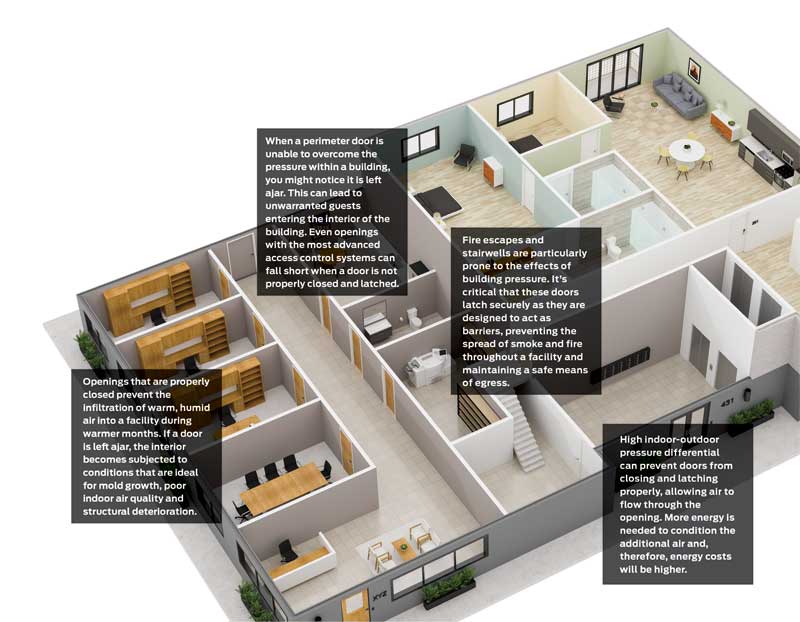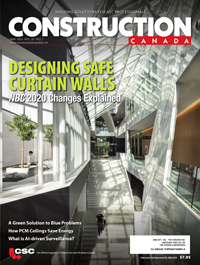Combating building pressure at the door

Door closers and building pressure
The effects of building pressure are known throughout the industry, but determining which openings will be affected—if any at all—can be tricky. It neither happens on every opening, nor in every building. There is no perfect solution, as it can be difficult to know how great the pressure differentials will be until the building is completed.
While nobody can know for certain how building pressure will affect each opening, early preparation is possible. This is why building designers strive to be proactive during the design phase. Architects want to do anything they can upfront to address issues before they become problems. For instance, when looking at plans, one might notice an exterior door is positioned in a manner allowing the north wind to “grab” it as it opens. The architect could change the direction of the door—however, what about cases when the direction cannot be changed, or repositioning would not change the impact of building pressure? That is where the correct door hardware can make a world of difference.
Architects and building designers should be aware of potential issues upfront and plan for what might need to be addressed later. Will the building have pressurized stairwells? Is there high wind in the area? Will the building sit atop a hill? How often will it be used? Who will use it—children or adults? It is also important to think about the climate. Areas with extreme temperatures are much more susceptible to higher pressure differentials.
All these factors should be considered during the design phase of the project, as they help indicate what type of closer is needed to overcome the likelihood of building pressure. When it has been determined an opening will be affected, it is best to specify a heavy-duty closer or auto-operator. A heavy-duty door closer helps control the door, especially when shutting. This type of closer has a larger piston and spring than a typical closer. An automatic operator controls both the opening and closing of the door without the need for physical contact. Another recommended product is an overhead stop to protect the door as it opens.
If the opening is an accessible opening, an auto-operator is required. In some cases, this type of hardware can be considered even if the opening is not required to be accessible. If the door is going to see a high level of pressure or abuse, auto-operators are specified for ease of use and convenience. They cost more upfront, but specifying an effective closer at the start is more economical than installing one down the road. It both saves clients the hassle, and can also result in long-term savings.
Building pressure risks
Building pressure can cause various problems related to doors, affecting accessibility, security, and energy efficiency unless an appropriate door closer is used.
Accessibility
There is a struggle between maintaining a properly latched door and accessibility. If a building has too much positive pressure, it can result in doors unable to close and latch securely. Facility managers typically try to address this by adjusting the door closers or replacing them with larger ones. While this might do the trick, installing an overly large closer can result in serious code violations.
Interior nonfire doors in a barrier-free path of travel should be operable with 22 N (5 lb) of force or less. However, in an effort to compensate for building pressure, closer power is often increased to enable the door to close and latch. The door will have enough force to shut, but the larger closing torques may reduce accessibility, restricting access for elderly or disabled occupants. Additionally, when pressure differential is relatively large, a door closer with low opening force may comply with barrier-free requirements, but may not be able to overcome the resistance and fully latch the door, allowing it to remain open. A solution to this is to specify a barrier-free door operator that both opens the door automatically for those that need assistance and closes and latches the door.
Doors unable to latch securely are of particular concern in exit stairwells, which are subject to the most extreme effects of building pressure due to their construction. The doors to these exit enclosures are designed to act as barriers, preventing the spread of smoke and fire throughout a facility and maintaining a safe means of egress. However, if a door cannot latch securely because the closer cannot overcome the pressure differential, occupants may not be able to evacuate safely, and the damage from the smoke and fire could be more extensive.
There are limitations on opening force for both accessibility and egress. Additionally, fire doors are required to have enough closing force to reliably close and latch the door. It is important to be cautious when installing a closer with a larger spring size or increasing the closer speed to overcome stack pressure. These methods may solve the problem, but frequently result in openings that no longer meet opening force limitations.
Additionally, closer adjustment is often performed improperly and results in a door closing too quickly when the pressure difference is not impacting the opening, causing excess stress and wear on the hinges, latching hardware, frame, and the door itself. This also creates the potential liability of someone being injured by an uncontrolled slamming door.
Security
From multi-use facilities to hospitals to residence halls, security is top of mind throughout the design process of many projects. Design/construction professionals may follow codes and guidelines, specify the best door hardware, and plan for access control solutions, only to find there is an invisible force working against the facility—building pressure.
When a door is unable to overcome the pressure within a building, one might notice it is left ajar. This is especially concerning at a perimeter door, where unwarranted guests can enter the facility. This means the building is at risk for unauthorized access, hardware damage, and even injury.
Even openings with the most advanced access control systems can fall short when faced with building pressure. These electronic solutions are designed to enhance security, but for them to function effectively, the closer must completely shut and latch the door. It is counterproductive to have electronic access control solutions on a door with a closer that does not work.
In addition to the security features, a benefit of this technology is users can efficiently monitor doors from afar, not needing to manually inspect the openings. If a door does not properly close, users will be notified with alarms. They then must send someone out to the door to verify whether it has been breached or simply failed to close.
Again, one way to overcome this issue is to adjust the spring size of the closer. However, if the valve is modified to control speed, it can cause other problems. As mentioned, a door closer adjusted to overcome high pressure differentials during the warmer months may slam shut as temperatures start to cool and pressures lower. An effective closer not only properly shuts a door when pressure is high, but also prevents the door from slamming when the differential is not impacting the opening. Any full-feature Builders Hardware Manufacturers Association (BHMA) Grade 1 surface door closer can effectively accomplish this by controlling swing speed, latch speed, and back check.





